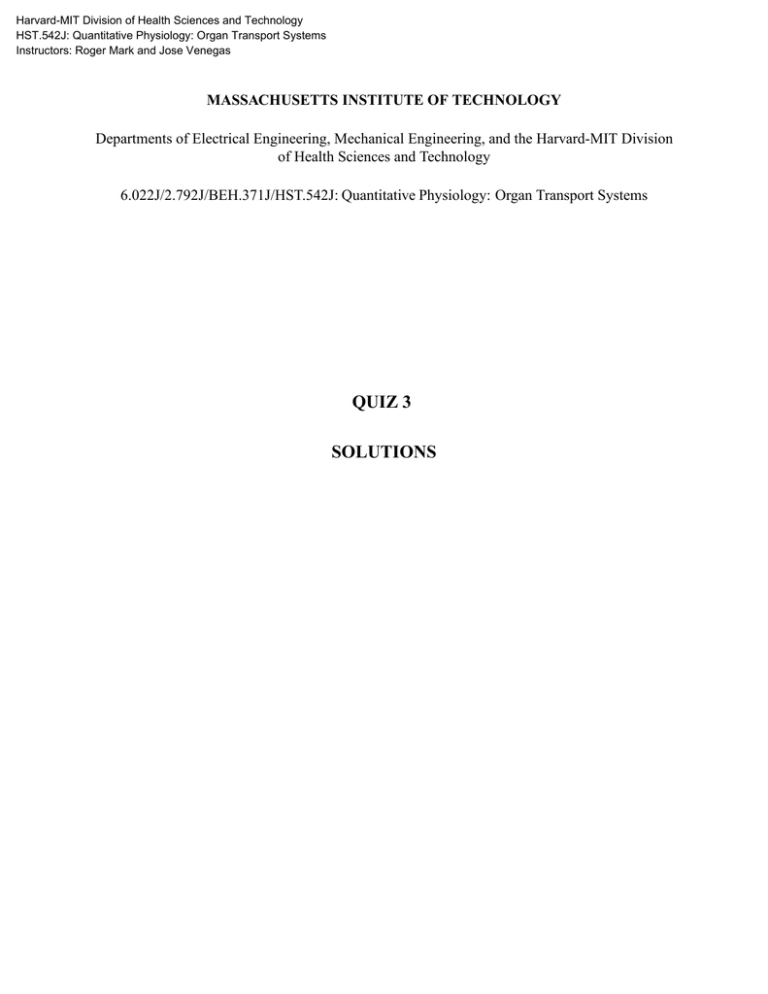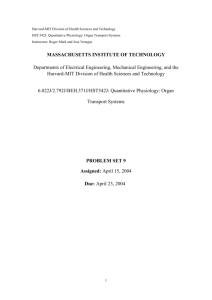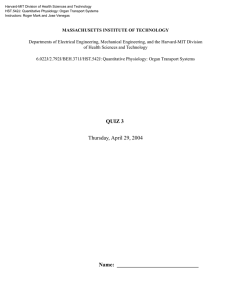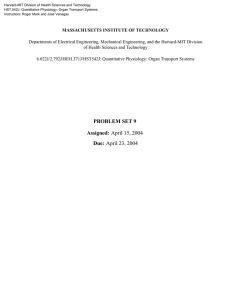Harvard-MIT Division of Health Sciences and Technology
advertisement

Harvard-MIT Division of Health Sciences and Technology HST.542J: Quantitative Physiology: Organ Transport Systems Instructors: Roger Mark and Jose Venegas MASSACHUSETTS INSTITUTE OF TECHNOLOGY Departments of Electrical Engineering, Mechanical Engineering, and the Harvard-MIT Division of Health Sciences and Technology 6.022J/2.792J/BEH.371J/HST.542J: Quantitative Physiology: Organ Transport Systems QUIZ 3 SOLUTIONS These are normal values of physiological parameters for a 70 kg person. Rrs (respiratory system R) Ccw Clung VD (Anatomic) VO� 2 � VCO 2 RQ Q s /Q T (Shunt fraction) Q T (cardiac output) Patm PvCO2 PvO2 PaCO2 PaO2 (at room air) ( A − a)D O2 pH cHb Hb O2 Binding capacity FRC = = = = = = = < = = = = = = ≈ = = = = 4 200 200 150 274 220 0.8 0.05 5 760 46 40 40 100 6-10 7.4 15 20.1 2.4 mbar·s/l ml/mbar ml/mbar ml ml/min ml/min l/min mmHg mmHg mmHg mmHg mmHg mmHg g/100ml-blood ml O2/100ml blood l The normal hemoglobin O2 saturation curve is also included and should be used only when there is no alternative data available. Figure 1: The first two problems are cases that include certain respiratory physiologic abnormalities. You can use the normal values as a reference, or in absence of additional information. 6.022j—2004: Quiz 3 solutions 2 Problem 1 (Case 1) A patient comes to the emergency ward with shortness of breath and wheezing. He is breath­ ing room air at a rate of 30 breaths per minute, and the pulse oximeter shows his arterial blood saturation to be SaO2 = 0.80. Arterial and mixed venous blood samples are taken at arrival and reveal the following values: PvCO2 PvO2 PaCO2 PaO2 (at room air) = = = = 44 27 39 20 mmHg mmHg mmHg mmHg The blood gas data comes with a computer generated caution questioning the validity of the measurements. A. Please identify which of the four blood gas values may have an error and explain your rea­ soning. (25%) PaO2 cannot be correct for two reasons: (i) PaO2 is always ≥ PvO2 (ii) PaO2 = 20 is not compatible with SaO2 = 0.8. In fact SaO2 ≈ 0.35. B. You need to make a best guess to treat the patient with the knowledge available to you; can you find an approximate value of the erroneous blood gas? (25%) For SaO2 = 0.8, PaO2 = 45 (from the O2 saturation curve). 6.022j—2004: Quiz 3 solutions 3 C. The patient is given 100% O2 by mask and one hour later his blood gases come back: PvCO2 PvO2 PaCO2 PaO2 = = = = 48 47 42 60 mmHg mmHg mmHg mmHg This time without caution notes. What can you say about the cause of gas exchange impairment in this patient? (50%) Hint, you can ignore the oxygen carrying capacity of plasma in your calculations. From alveolar gas eq: � � PaCO2 PAO2 ≈ FIO2 Patm − PH 2 O − RQ 42 = 1(713) − = 660 � 60 0.8 Given that the paitent is breathing at FIO2 = 1, this large 660 − 60 = (A − a) DO2 gradient can only be explained by shunt. Using the approximate shunt equation 1 − 0.9 0.1 1 − sata,O2 Qs = = = = 0.56 Qt 1 − satv,O2 1 − 0.82 0.18 This patient has a 56% shunt fraction. 6.022j—2004: Quiz 3 solutions 4 Problem 2 (Case 2) The same patient eventually develops respiratory failure and is placed on a mechanical ventilator adjusted to parameters matching his tidal breathing: VT = 390 ml f = 30 bpm Tins = 40% Texp = 50% Fi O2 = 0.50 And his blood gases are measured as: PvCO2 PvO2 PaCO2 PaO2 = = = = 42 45 40 275 mmHg mmHg mmHg mmHg V̇O2 V̇CO2 = = 274 ml/min 220 ml/min The ventilator output shows the following screen Figure 2: 6.022j—2004: Quiz 3 solutions 5 A. Is this patient exhibiting dynamic hyper-inflation, and why or why not? (25%) Yes, because expiratory flow at the end of exhalation is non-zero. B. Can you estimate the patient’s respiratory system mechanical parameters: Resistance and Compliance? (25%) R = Ppeak − Pplateau V̇ = 21 − 11 VT tinsp = 2.05 mbar·s/L C = VT Ppeak−Pini = =� 10 390 2×0.4 � 390 = 78 ml/mbar 21 − 16 RC = 78 × 0.0205 = 1.6 sec 6.022j—2004: Quiz 3 solutions 6 C. The attending MD suggests decreasing frequency while keeping the inspiration (insufflation in Germanic English) and exhalation time % unchanged. What frequency and tidal volume would you choose? Assume that the VD physiologic remains unchanged. (50%) (Note: if you decide to use VD anatomic in your calculation, you will lose 25% of the question points.) To avoid hyperinflation: ≥ 4 × RC = 4 × 1.6 = 6.4 sec 1 texp % = 50% ⇒ f 2 = 6.4 × 60 = 4.7 bpm texp 0.5 To keep a constant V̇ A , we need to calculate a VT such that � � � � VT1 − V D f 1 = VT2 − V D f 2 � � f1 VT2 = VT1 − V D + VD f2 We know that VD VCO2 =1− VT VT f FACO2 where FACO2 ≈ PaCO2 (Patm − 47) 220 V D = 1 − = 0.665 40 VT 390 × 30 × 713 V D = 0.665 × 390 = 259.35 ml 30 VT2 = (390 − 259.35) + 290.35 4.7 = 1124 ml VT2 = 1.124 L f 2 = 4.7 bpm 6.022j—2004: Quiz 3 solutions 7 Problem 3 Pulmonary fibrosis is a debilitating disease of the lung characterized by replacement of elastin by collagen and resulting in a decrease of lung compliance. In severe cases, lung transplant is the only option for survival. To maximize organ availability and reduce post-operative mortality, usually unilateral lung transplant is conducted. A. First draw the normal chest wall and lung compliance curves. Then draw changes that result from pulmonary fibrosis (C L reduced by 1/2). Assume that compliances are linear and that the chest wall compliance does not change. What happens with FRC in pulmonary fibrosis? (25%) Volume Normal lung After transplant Fibrotic lung For CW: VCW = VCW 0 + PPL CCW → PPL = VCW − VCW 0 CCW For lungs: ⎛ ⎞ −VL VL + ⎝ Pa0 −PPL ⎠ C L = −PPL C L → PPL = ���� CL =0 FRC = Lung Volume, where VL = VCW and PPLCW = PPL L . 6.022j—2004: Quiz 3 solutions 8 ⇒ VCW − VCW 0 −VL = CCW CL For VL = VCW = FRC FRC − VCW 0 = −FRC FRC = CCW CL VCW 0 1+ CCW CL For normal lung CCW = C L → FRC = VCW 0 2 For fibrotic lung CL F = VCW 0 CL VCW 0 → FRC = + 1 3 2 1 + 1/2 B. Second, draw the effects of replacing one of the lungs with a normal donor lung. What will be the new FRC after surgery? You can assume that both right and left lungs have equal compliance before surgery. (25%) After transplant: C L ,post = CL 4 ↑ CL 2 ↑ + fibrotic lung 3 = CL 4 transplanted “normal” lung So FRC = 6.022j—2004: Quiz 3 solutions VCW 0 1+ 4 3 = 3 VCW 0 7 9 C. How does the amount of pressure required to inspire a similar tidal volume compare between before and after surgery? (25%) Total lung compliance Before transplant: 1 VT VT CL F = CL = ⇒ �P = � � CL 2 �P 2 After transplant: CL F CL CL CL 3 + = + = CL 2 2 4 �2 �4 4 VT VT → �Pafter = = 3 3 CL C L 4 � � VT VT = � � =2 CL CL C L ,post = �Pafter �Pbefore 2 For the same VT 4 �Pafter 2 = 3 = �Pbefore 2 3 After transplant the person needs two-thirds the pleural pressure to generate the same total VT . D. In what proportions is the tidal volume distributed between both lungs? (25%) VT distributes with regional C. VTtranpl = 2VTfibrotic 6.022j—2004: Quiz 3 solutions 10




